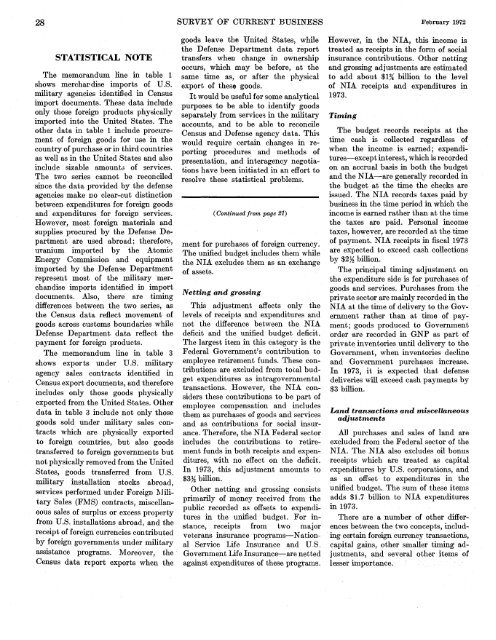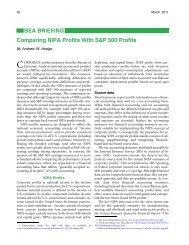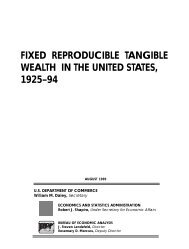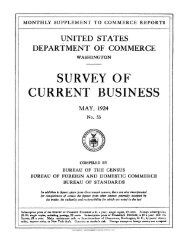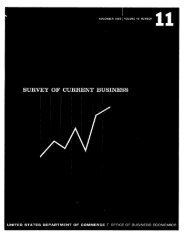current business statistics - Bureau of Economic Analysis
current business statistics - Bureau of Economic Analysis
current business statistics - Bureau of Economic Analysis
Create successful ePaper yourself
Turn your PDF publications into a flip-book with our unique Google optimized e-Paper software.
28 SURVEY OF CURRENT BUSINESS February 1972<br />
STATISTICAL NOTE<br />
The memorandum line in table 1<br />
shows merchandise imports <strong>of</strong> U.S.<br />
military agencies identified in Census<br />
import documents. These data include<br />
only those foreign products physically<br />
imported into the United States. The<br />
other data in table 1 include procurement<br />
<strong>of</strong> foreign goods for use in the<br />
country <strong>of</strong> purchase or in third countries<br />
as well as in the United States and also<br />
include sizable amounts <strong>of</strong> services.<br />
The two series cannot be reconciled<br />
since the data provided by the defense<br />
agencies make no clear-cut distinction<br />
between expenditures for foreign goods<br />
and expenditures for foreign services.<br />
However, most foreign materials and<br />
supplies procured by the Defense Department<br />
are used abroad; therefore,<br />
uranium imported by the Atomic<br />
Energy Commission and equipment<br />
imported by the Defense Department<br />
represent most <strong>of</strong> the military merchandise<br />
imports identified in import<br />
documents. Also, there are timing<br />
differences between the two series, as<br />
the Census data reflect movement <strong>of</strong><br />
goods across customs boundaries while<br />
Defense Department data reflect the<br />
payment for foreign products.<br />
The memorandum line in table 3<br />
shows exports under U.S. military<br />
agency sales contracts identified in<br />
Census export documents, and therefore<br />
includes only those goods physically<br />
exported from the United States. Other<br />
data in table 3 include not only those<br />
goods sold under military sales contracts<br />
which are physically exported<br />
to foreign countries, but also goods<br />
transferred to foreign governments but<br />
not physically removed from the United<br />
States, goods transferred from U.S.<br />
military installation stocks abroad,<br />
services performed under Foreign Military<br />
Sales (FMS) contracts, miscellaneous<br />
sales <strong>of</strong> surplus or excess property<br />
from U.S. installations abroad, and the<br />
receipt <strong>of</strong> foreign currencies contributed<br />
by foreign governments under military<br />
assistance programs. Moreover, the<br />
Census data report exports when the<br />
goods leave the United States, while<br />
the Defense Department data report<br />
transfers when change in ownership<br />
occurs, which may be before, at the<br />
same time as, or after the physical<br />
export <strong>of</strong> these goods.<br />
It would be useful for some analytical<br />
purposes to be able to identify goods<br />
separately from services in the military<br />
accounts, and to be able to reconcile<br />
Census and Defense agency data. This<br />
would require certain changes in reporting<br />
procedures and methods <strong>of</strong><br />
presentation, and interagency negotiations<br />
have been initiated in an effort to<br />
resolve these statistical problems.<br />
(Continued from page 21)<br />
ment for purchases <strong>of</strong> foreign currency.<br />
The unified budget includes them while<br />
the NIA excludes them as an exchange<br />
<strong>of</strong> assets.<br />
Netting and grossing<br />
This adjustment affects only the<br />
levels <strong>of</strong> receipts and expenditures and<br />
not the difference between the NIA<br />
deficit and the unified budget deficit.<br />
The largest item in this category is the<br />
Federal Government's contribution to<br />
employee retirement funds. These contributions<br />
are excluded from total budget<br />
expenditures as intragovernmental<br />
transactions. However, the NIA considers<br />
these contributions to be part <strong>of</strong><br />
employee compensation and includes<br />
them as purchases <strong>of</strong> goods and services<br />
and as contributions for social insurance.<br />
Therefore, the NIA Federal sector<br />
includes the contributions to retirement<br />
funds in both receipts and expenditures,<br />
with no effect on the deficit.<br />
In 1973, this adjustment amounts to<br />
$3% billion.<br />
Other netting and grossing consists<br />
primarily <strong>of</strong> money received from the<br />
public recorded as <strong>of</strong>fsets to expenditures<br />
in the unified budget. For instance,<br />
receipts from two major<br />
veterans insurance programs—National<br />
Service Life Insurance and U.S.<br />
Government Life Insurance—are netted<br />
against expenditures <strong>of</strong> these programs.<br />
However, in the NIA, this income is<br />
treated as receipts in the form <strong>of</strong> social<br />
insurance contributions. Other netting<br />
and grossing adjustments are estimated<br />
to add about $1% billion to the level<br />
<strong>of</strong> NIA receipts and expenditures in<br />
1973.<br />
Timing<br />
The budget records receipts at the<br />
time cash is collected regardless <strong>of</strong><br />
when the income is earned; expenditures—except<br />
interest, which is recorded<br />
on an accrual basis in both the budget<br />
and the NIA—are generally recorded in<br />
the budget at the time the checks are<br />
issued. The NIA records taxes paid by<br />
<strong>business</strong> in the time period in which the<br />
income is earned rather than at the time<br />
the taxes are paid. Personal income<br />
taxes, however, are recorded at the time<br />
<strong>of</strong> payment. NIA receipts in fiscal 1973<br />
are expected to exceed cash collections<br />
by $2% billion.<br />
The principal timing adjustment on<br />
the expenditure side is for purchases <strong>of</strong><br />
goods and services. Purchases from the<br />
private sector are mainly recorded in the<br />
NIA at the time <strong>of</strong> delivery to the Government<br />
rather than at time <strong>of</strong> payment;<br />
goods produced to Government<br />
order are recorded in GNP as part <strong>of</strong><br />
private inventories until delivery to the<br />
Government, when inventories decline<br />
and Government purchases increase.<br />
In 1973, it is expected that defense<br />
deliveries will exceed cash payments by<br />
$3 billion.<br />
Land transactions and miscellaneous<br />
adjustments<br />
All purchases and sales <strong>of</strong> land are<br />
excluded from the Federal sector <strong>of</strong> the<br />
NIA. The NIA also excludes oil bonus<br />
receipts which are treated as capital<br />
expenditures by U.S. corporations, and<br />
as an <strong>of</strong>fset to expenditures in the<br />
unified budget. The sum <strong>of</strong> these items<br />
adds $1.7 billion to NIA expenditures<br />
in 1973.<br />
There are a number <strong>of</strong> other differences<br />
between the two concepts, including<br />
certain foreign currency transactions,<br />
capital gains, other smaller timing adjustments,<br />
and several other items <strong>of</strong><br />
lesser importance.


